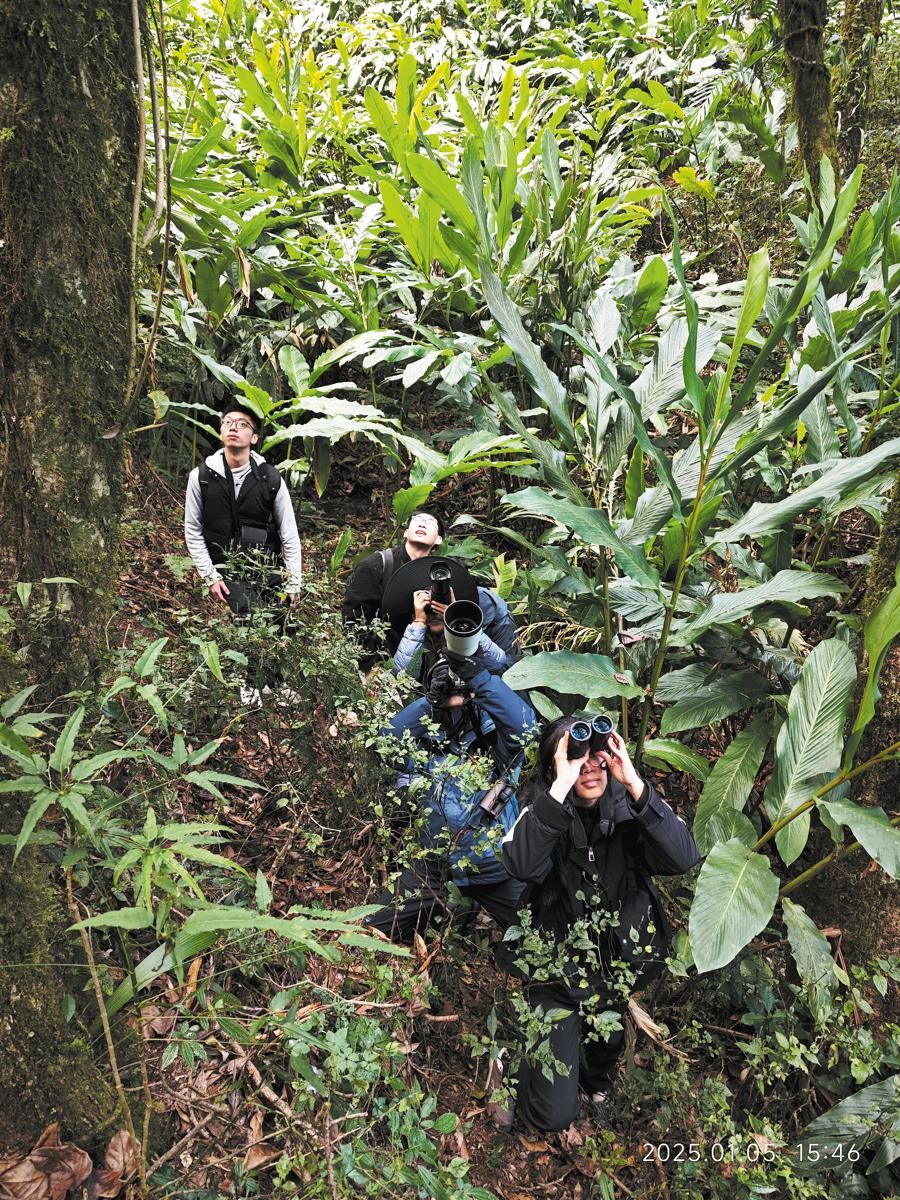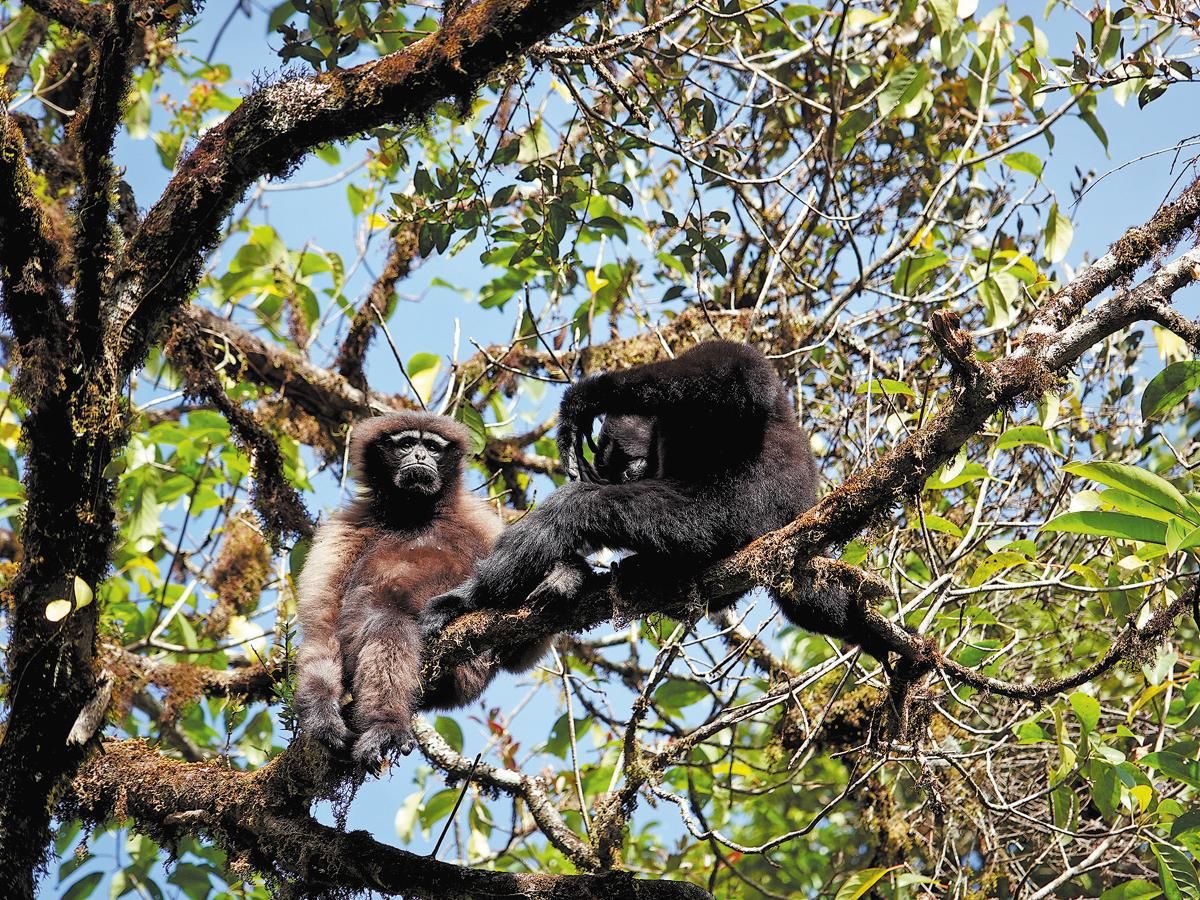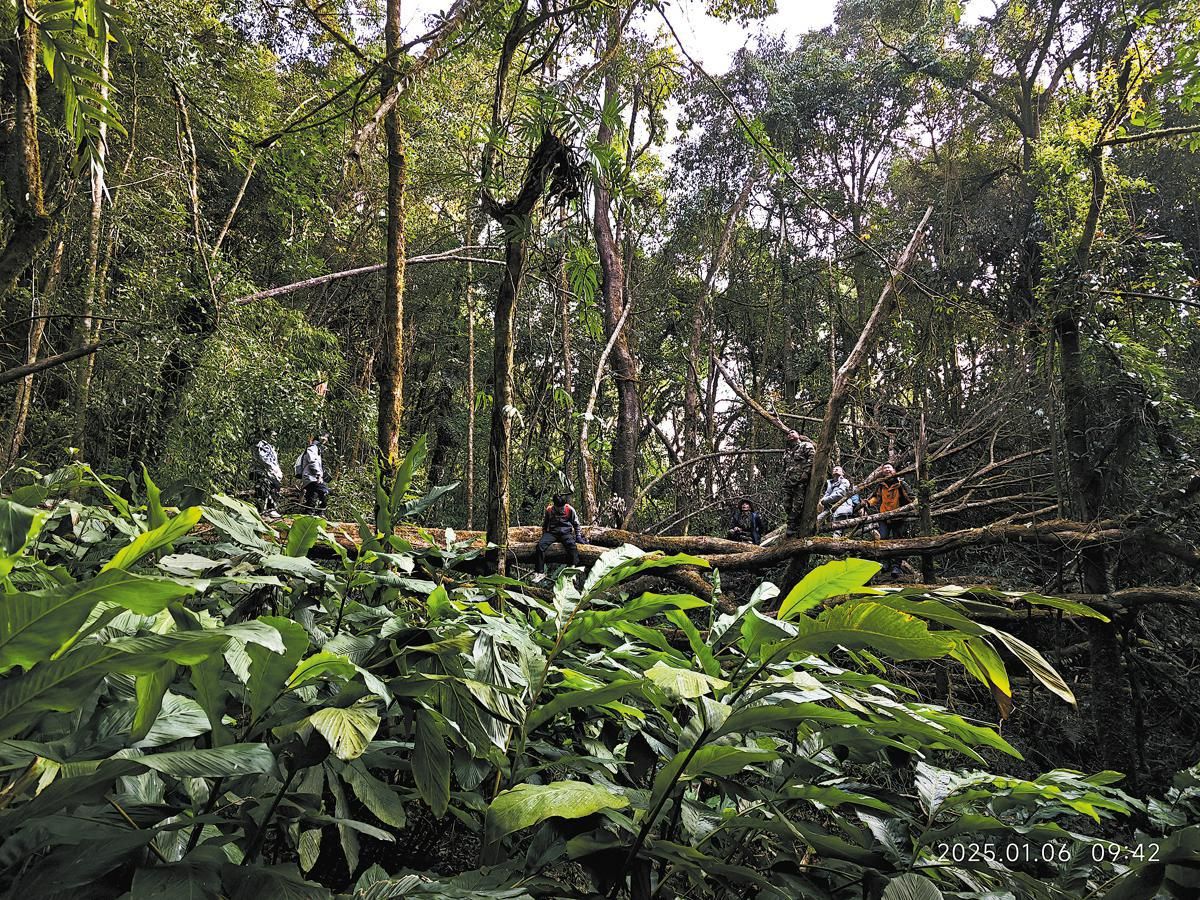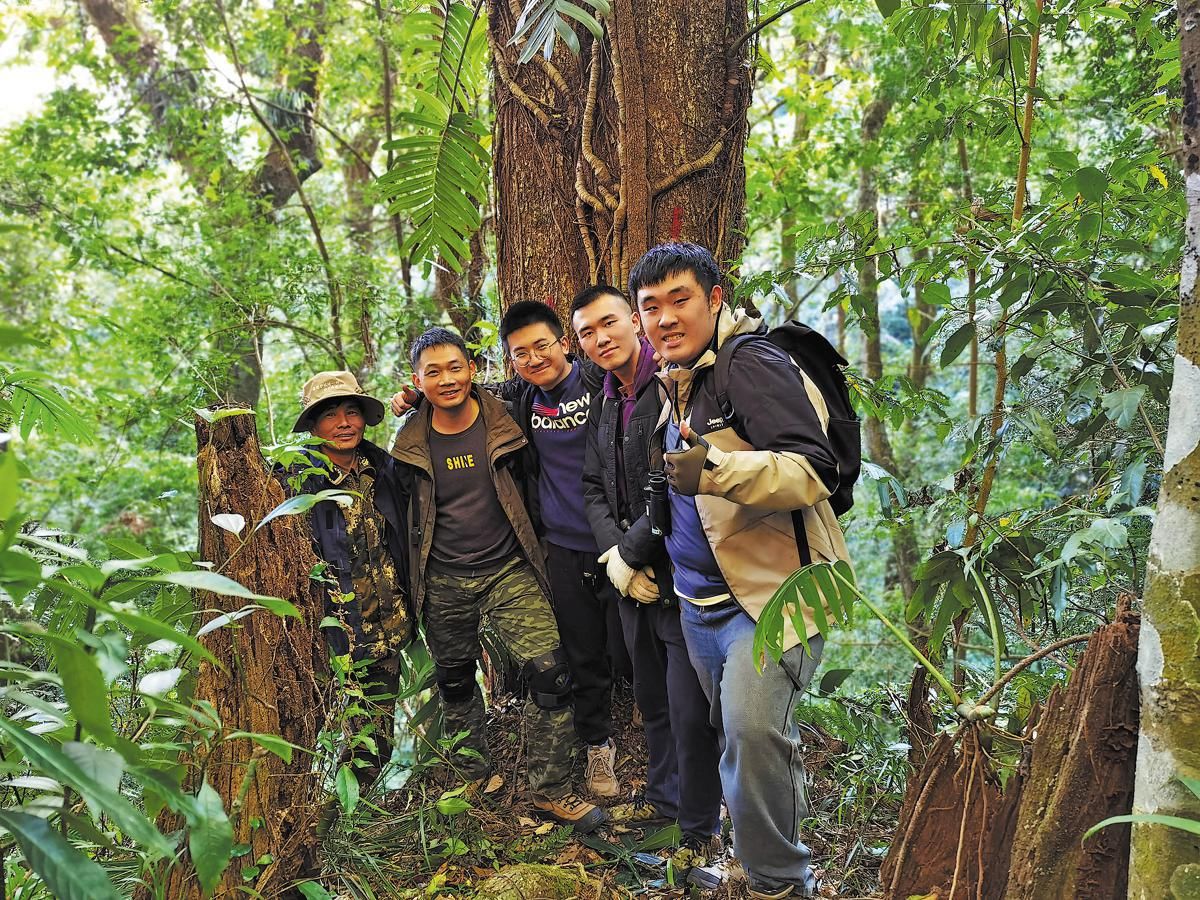
Students from Sun Yat-sen University in Guangzhou, Guangdong province, observe Skywalker hoolock gibbons in a collective forest with Chinese black cardamom in Baoshan, Yunnan province, on Jan 5. FAN PENGFEI/FOR CHINA DAILY
In the lush tropical and mountain forests of Southeast Asia reside various species of gibbons — small apes highly sensitive to environmental changes.
Serving as indicator species for forest conservation in many countries, all gibbon species face threats of habitat loss and degradation, with most now classified as endangered or critically endangered.
Similar to other gibbon species, the Skywalker hoolock gibbon (Hoolock tianxing) is a quintessential arboreal forest dweller, relying primarily on ripe fruit for sustenance.
Notably, the Skywalker hoolock gibbon is the first ape species named by Chinese scientists.
A 2017 survey estimated that fewer than 200 Skywalker hoolock gibbons inhabit China, primarily in the Gaoligongshan National Nature Reserve in Baoshan, Yunnan province, and parts of Yingjiang and Tengchong counties in the province.
Because the Lisu people harbor a traditional culture of protecting the gibbons, nearly half of China's Skywalker gibbon population inhabit collective forests near Lisu villages in Yingjiang and Tengchong.
The collective forests, about 45 kilometers from the Gaoligongshan nature reserve where the Skywalker hoolock gibbon's southern population lives, serve as habitats for the species and vital income sources for local villagers.
Cultivating Chinese black cardamom (Amomum tsaoko), also known as caoguo, a shade-loving plant, in these forests has become a significant economic activity for the communities.
In Southeast Asia, Chinese black cardamom cultivation stands as a time-honored and widely embraced agroforestry practice. By 2018, global cardamom cultivation covered nearly 300,000 hectares, with China accounting for 78 percent, primarily in Yunnan.
To optimize the yield of cardamom, professor Fan Pengfei from the Life Science College of Sun Yat-sen University in Guangzhou, Guangdong province, explained that "farmers choose to fell trees and clear portions of the undergrowth in forests".
This practice aims to augment sunlight exposure while maintaining the necessary shade levels conducive to the robust growth of cardamom.

Two Skywalker hoolock gibbons rest on the canopy of a collective forest in Baoshan. ZHU CHANGYUE/FOR CHINA DAILY
"According to some research, forests hosting caoguo cultivation could experience a reduction in canopy coverage ranging from 25 percent to 50 percent," Fan, who named the Skywalker hoolock gibbon, told China Daily. "The overall canopy structure of the forest ecosystem would be changed."
Despite being a relatively less damaging agricultural practice to forest structure, cardamom cultivation may reduce the density of food trees for Skywalker hoolock gibbons and impede their efficient foraging due to the discontinuity in the forest canopy.
In response to this scenario, Fan and his team conducted long-term field observations and comparative studies on the gibbons living in the Gaoligongshan nature reserve's forests where cardamom is grown.
They published their findings in the article "Cardamom (Amomum tsaoko) agroforest is important habitat for skywalker hoolock gibbon (Hoolock tianxing) in Mt Gaoligong, Yunnan, China", in Global Ecology and Conservation, an open access international scientific journal, in October.

Chinese black cardamom grows rampant in a patch of collective forest in Baoshan. FAN PENGFEI/FOR CHINA DAILY
Surprising findings
What they found deepened the understanding of these endangered small apes. "Their adaptability to environmental changes is better than we expected," Fan said.
Their research compared the daily behaviors of the gibbons in the black cardamom forests and the nature reserve, focusing on their eating habits in different seasons, time allocation, home range, daily travel distances each month, reproductive patterns and group sizes.
"By analyzing data derived from these parameters, we could understand the gibbons' adaptation to the cardamom forests, evaluate the long-term suitability of these habitats for gibbons and offer tailored conservation strategies," Fan said.
The study revealed differences in food choices between the two populations of Skywalker hoolock gibbons. While the gibbons in the nature reserve primarily consume fruit, those in forests with black cardamom had to adjust their diet by consuming more leaves, and occasionally nuts during October and November.
"This shift isn't driven by a preference for certain food," Fan explained.
"Rather, it's because they had to broaden their menu to deal with the scarcity of fruit."
Interestingly, he said, the gibbons in the cardamom forests exhibited more active behavior, spending an average of 9.2 hours per day moving within the forests, 0.6 hours more than their counterparts in the nature reserve.
"The gibbons in the caoguo forests allocate an additional 0.7 hours to foraging compared to those in the reserve," he said. "After all, compared to such 'energy bombs' as fruit, leaves are just 'low-calorie food'. It naturally takes them more time to eat their fill."
However, despite the challenges of limited resources, both populations maintained similar daily routines — spending most of the time resting after moving and foraging.
"Noteworthily, the gibbons in both habitats spent similar amounts of time in social intercourse — grooming and playing with each other," the zoologist said.
Another finding is that despite some habitat disturbance, the gibbons in the black cardamom forests did not expand their home ranges or increase their daily travel in most months compared to those in the nature reserve.
More interestingly, in times of fruit scarcity from June to August, they reduced travel distances and focused on leaf consumption to conserve energy, he said.
In the black cardamom forests, the female gibbons in a study group gave birth in 2008 and 2012 but did not reproduce afterward, possibly due to aging. And the other two groups in the cardamom forests had average reproductive intervals of 6 years and 3 years.
Another group in the reserve had average reproductive intervals of 3 years.
"Between 2017 and 2023, we conducted field surveys on 17 Skywalker gibbon groups, nine of them living in the cardamom forests while the remaining eight inhabited the primary forests," Fan said. "There were no obvious differences in group sizes between the two populations."
Overall, the study indicated that the cardamom forests could support gibbon reproduction and maintain group sizes, with no significant differences compared to those living in the reserve's primary forests.

Professor Fan Pengfei (second from left) poses with his students during a field survey in Baoshan last week. CHINA DAILY
Tailored conservation
The impact of black cardamom cultivation on Skywalker hoolock gibbons is multifaceted, Fan said. While it alters forest structure and potentially affects the gibbons' activities and dispersion, it also serves as a protective measure against more destructive land-use practices such as slash-and-burn agriculture or logging.
"We long for improved habitats for the gibbons, while also wishing for the local people to have sustainable livelihoods," Fan said.
"So I think we should treat the caoguo forests with a more optimistic mindset. They are not perfect, but they still provide the opportunity for a harmonious coexistence between the gibbons and humans."
As a result, the researcher suggests that compared to felled forests for farming lands, agroforestry practices in secondary forests should be encouraged to minimize impacts on forest structure and protect the integrity of collective forests, providing a sustainable habitat for the gibbons and other forest animals.
"In the collective forests, we suggest preserving or planting tree species preferred by the gibbons to support their foraging habits," he said.
Additionally, he suggested raising conservation awareness among local residents through environmental education, making them active participants in ecological preservation.
Link to the report: https://www.chinadaily.com.cn/a/202501/10/WS67806f85a310f1265a1da008_1.html



